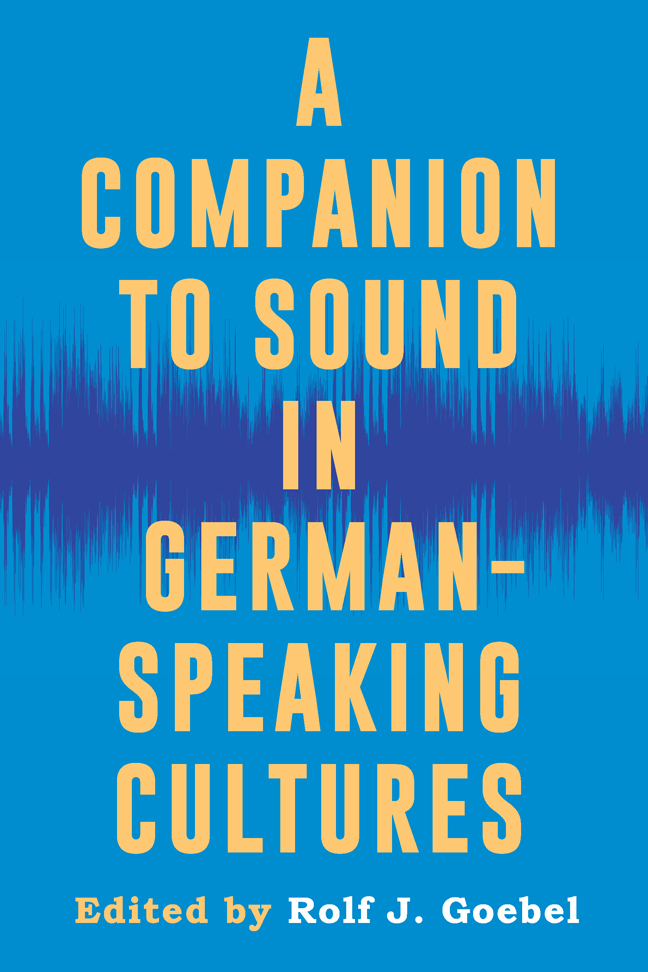Book contents
- Frontmatter
- Contents
- List of Illustrations
- Preface
- Introduction
- Part I Sonic Practices from the Middle Ages to the Nineteenth Century
- Part II Rediscovering the Sounds of Modernism
- Part III Listening to the Unbearable: The Sounds of National Socialism and the Holocaust
- Part IV After the Catastrophe: Sounds in Postwar Germany and Beyond
- Part V Sounds of the Present
- Part VI Epilogue
- Select Bibliography and Further Reading
- Notes on the Contributors
- Index
5 - New Hearing: Soundscapes of Literary Modernism
Published online by Cambridge University Press: 21 February 2024
- Frontmatter
- Contents
- List of Illustrations
- Preface
- Introduction
- Part I Sonic Practices from the Middle Ages to the Nineteenth Century
- Part II Rediscovering the Sounds of Modernism
- Part III Listening to the Unbearable: The Sounds of National Socialism and the Holocaust
- Part IV After the Catastrophe: Sounds in Postwar Germany and Beyond
- Part V Sounds of the Present
- Part VI Epilogue
- Select Bibliography and Further Reading
- Notes on the Contributors
- Index
Summary
Our ears are more finely attuned now.
—Arno HolzI. Introduction: The Sound in the Picture
Each literary epoch sounds differently, and that holds true not just in a metaphorical sense. A comparison between two texts, one from Realism, the other from Modernism, is suitable to elucidate this thesis. In the beginning of his novel Stine, first published in 1889/90, Theodor Fontane maps out an (almost) everyday street scenario, located in the middle of Berlin:
In der Invalidenstraße sah es aus wie gewöhnlich: die Pferdebahnwagen klingelten, und die Maschinenarbeiter gingen zu Mittag und wer durchaus was Merkwürdiges hätte finden wollen, hätte nichts anderes auskundschaften können, als daß in Nummer 98 e die Fenster der ersten Etage—trotzdem nicht Ostern und nicht Pfingsten und nicht einmal Sonnabend war—mit einer Art Bravour geputzt wurden.
[Invalidenstraße looked the way it always does: the horsecarts were ringing their bells and the factory workers were going on their lunch break, and if anybody had insisted on finding something remarkable, they could have spied nothing but that the first-floor windows of no. 98 e—and this was not on Easter or Whitsunday, not even a Saturday—were being cleaned with a sort of bravura.]
Although the narrator states that Invalidenstraße “looked” as usual, and accordingly describes mostly visual phenomena, what he first mentions is, conspicuously enough, the bell ringing of the horsecars and hence a sound. As incidental and irrelevant as it might appear at first glance, or, rather, at first listen, the bell ringing is a specific as well as significant sound. For Fontane's contemporaries, it was a clear hint to the time in which the story takes place: the present or recent past, the terminus post quem being the introduction of the horsecar in Berlin in 1865. The bell ringing of the horsecars thus functions as a marker of time: from it alone, attentive contemporary readers were able to deduce that they were about to read a novel about Berlin in the Gründerzeit (in fact, the story takes place in August 1877 or 1878). Space, and with it social status, is also marked by the bell-ringing, for at that time the horsecars followed selected routes through the city only, thereby favoring the infrastructure of certain districts.
- Type
- Chapter
- Information
- A Companion to Sound in German-Speaking Cultures , pp. 82 - 97Publisher: Boydell & BrewerPrint publication year: 2023

